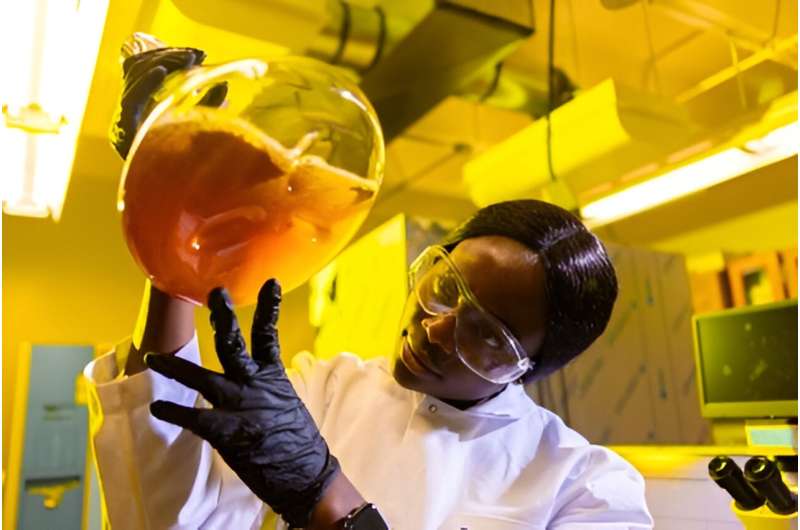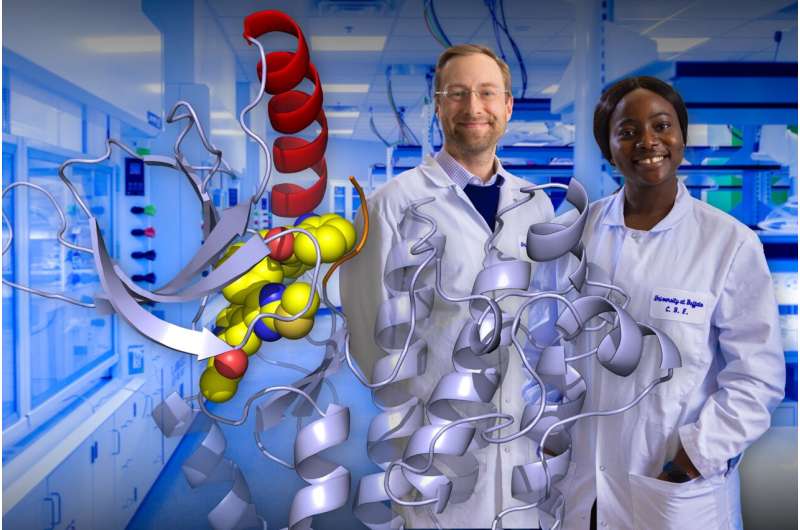This article has been reviewed according to Science X's editorial process and policies. Editors have highlighted the following attributes while ensuring the content's credibility:
fact-checked
peer-reviewed publication
trusted source
proofread
Study proposes streamlined approach to developing cancer drugs

Drug discovery can be a frustrating process of trial and error. Scientists using fragment-based drug discovery link fragments of different molecules together to create a more potent drug but may not know whether a compound works until millions of dollars in research and development have already been spent.
New University at Buffalo research may offer a more streamlined approach, allowing drug makers to determine the viability of a fragment-based design earlier in the process. While developing a fragment-based drug to treat lung cancer, a team co-led by UB found that where they linked fragments together had a large effect on potency.
"Despite consisting of the same molecule fragments, we found that one of our compounds was superadditive, while the other was virtually inactive. The main difference between the two was the points at which their fragments were linked together," says David Heppner, Ph.D., Jere Solo Assistant Professor of medicinal chemistry in the UB College of Arts and Sciences and co-senior author of the study, which published in Communications Chemistry.
Molecule fragments are often linked together using another molecule, typically called linkers. Much attention is paid to their length and the kinds of atoms inside, while their placement on fragments, or the points of connection, is often left up to chance.
But Heppner and his team say that determining the optimal point of connection at the onset, while perhaps cumbersome, is most efficient.
"We believe our approach adds more intelligence to the drug optimization process and minimizes the amount of work needed to find the most potent structure," says co-lead author Blessing Ogboo, a Ph.D. student in Heppner's lab.
The stakes are high in drug discovery: It's estimated that it takes on average 12 years and $2.7 billion to develop a new drug. Most drugs never even make it to the market—for example, 97% of cancer drugs fail clinical trials.
Fragment-based drug discovery, or FBDD, has become a sought-after method. Linked fragments can bind to a drug target, like a protein or enzyme, at multiple sites simultaneously, making them more potent than their parent molecules would be on their own.

The UB team was using FBDD to develop inhibitors that can bind to multiple sites on the kinase domain of the epidermal growth factor receptor (EGFR), a key protein in non-small cell lung cancer. One of their inhibitors was linked to a central group, while the other was connected through an outer region of the molecule.
When tested on an EGFR in a cell culture, the inhibitor linked through an outer region was more than 1 million times more potent.
Curious to understand why, the team used X-ray crystallography and molecular dynamic simulations to determine the two inhibitors' 3D structure and how they bind to EGFR.
The tools showed that the superior potency was due to the placement of its linker, allowing for greater mobility and better compatibility with the EGFR's binding site. They also ruled out more conventional attributes—length and atom type—being behind the increased potency.
"Previous studies have highlighted the importance of flexibility for linkers, but we believe our inhibitors are unique given their wide range of potency despite relatively small differences in linker structure," says co-lead author Stefan Laufer, Ph.D., of the Eberhard Karls University of Tübingen.
Other co-authors from UB include Tahereh Damghani, Ph.D., a postdoctoral research associate; Surbhi Chitnis, a Ph.D. student; and former graduate students Calvin Pham and Brandon Oligny. Other contributors represent Roswell Park Comprehensive Cancer Center, Harvard Medical School, the University of Eastern Finland, and AssayQuant Technologies, Inc.
Heppner and Laufer's teams have filed both a U.S. and international patent application on the EGFR inhibitors and are working with UB's Technology Transfer office.
The Heppner lab recently led another study on covalent EGFR inhibitors that was published in the Journal of Medicinal Chemistry. Written with collaboration industry partners, it serves as a perspective on best practices, as well as common pitfalls in drug development.
"We hope our recent studies and others like them can better inform decision making in the drug discovery process, creating cost savings and decreasing time to new therapies," Heppner says.
More information: Florian Wittlinger et al, Linking ATP and allosteric sites to achieve superadditive binding with bivalent EGFR kinase inhibitors, Communications Chemistry (2024). DOI: 10.1038/s42004-024-01108-3
Kristopher W. Hoyt et al, Pitfalls and Considerations in Determining the Potency and Mutant Selectivity of Covalent Epidermal Growth Factor Receptor Inhibitors, Journal of Medicinal Chemistry (2023). DOI: 10.1021/acs.jmedchem.3c01502
















